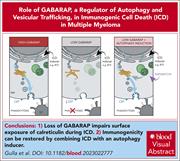Issue Archive
Table of Contents
BLOOD COMMENTARIES
REVIEW ARTICLE
Heparan sulfates and heparan sulfate proteoglycans in hematopoiesis
In addition to the widely appreciated role of heparan sulfates in thrombosis via their interaction with antithrombin, these membrane-glycated proteins have wide-ranging effects on hematopoietic stem cells and developing myeloid and lymphoid cells. Piszczatowski and coauthors present a state-of-the-art review of the role of heparan sulfates, and the proteoglycans to which they attach, in hematopoiesis.
CLINICAL TRIALS AND OBSERVATIONS
Reassessing the chronic lymphocytic leukemia International Prognostic Index in the era of targeted therapies
Clinical Trials & Observations
The chronic lymphocytic leukemia International Prognostic Index (CLL-IPI) delineates 4 prognostic subgroups predictive of overall survival (OS) for patients with CLL treated with chemoimmunotherapy. Langerbeins and colleagues performed a pooled analysis of patients treated with first-line targeted drugs vs chemoimmunotherapy to determine the continued validity of the CLL-IPI. All subgroups displayed improved progression-free survival (PFS) and OS with targeted therapy. The CLL-IPI remains prognostic for PFS in the setting of targeted therapy but has diminished predictive value for OS.
IMMUNOBIOLOGY AND IMMUNOTHERAPY
Integration of ζ-deficient CARs into the CD3ζ gene conveys potent cytotoxicity in T and NK cells
Kath and colleagues present preclinical data for a novel approach to chimeric antigen receptor (CAR)–redirected therapies that avoids viral gene transfer and uses CRISPR-Cas gene editing to insert transgenes into the CD3ζ locus, placing them under physiologic regulation and avoiding the risk of insertional mutagenesis and potential genotoxicity. These novel vectors had equivalent antileukemic activity and have the potential for the development of allogeneic off-the-shelf CAR therapies.
LYMPHOID NEOPLASIA
Loss of GABARAP mediates resistance to immunogenic chemotherapy in multiple myeloma
Bortezomib kills multiple myeloma (MM) cells by inducing immunogenic cell death (ICD). Although it induces durable responses, most patients develop bortezomib resistance and relapse. Gulla et al propose that resistance is linked to low expression of GABA type A receptor–associated protein (GABARAP) which decreases surface expression of calreticulin, an “eat me” signal mediating ICD. GABARAP is on chromosome 17p, often deleted in high-risk MM, and low GABARAP expression predicts decreased MM survival. GABARAP deletion blocks autophagy, and inducing autophagy with rapamycin restores bortezomib responsiveness in vitro, which is a potential approach to enhance bortezomib response.
MYELOID NEOPLASIA
Landscape of driver mutations and their clinical effects on Down syndrome–related myeloid neoplasms
Clinical Trials & Observations
Transient abnormal myelopoiesis (TAM) occurs in about 10% of newborns with Down syndrome (DS). It spontaneously regresses, but about 20% of patients later develop myeloid leukemia (ML-DS). ML-DS typically responds well to therapy, but patients with relapsed/refractory (R/R) disease have a very poor prognosis. Sato et al performed genomic profiling of patients with TAM, ML-DS, and non-DS megakaryoblastic leukemia to determine the molecular basis for R/R disease. Changes associated with poor outcome included mutations in TP53 and JAK2, tandem duplications of RUNX1 (on chromosome 21), and changes upregulating the MYC pathway. The delineation of prognostically important changes provides targets for potential therapy to improve prognosis in patients with high-risk disease.
THROMBOSIS AND HEMOSTASIS
Peak ADAMTS13 activity to assess ADAMTS13 conformation and risk of relapse in immune-mediated thrombotic thrombocytopenic purpura
Patients with immune-mediated thrombotic thrombocytopenic purpura (iTTP) respond well to current therapies, but 40% relapse within 5 years. It has been described recently that the molecular configuration of ADAMTS13 in acute iTTP is open and not all patients in remission revert to a closed conformation. Prasannan et al examined the predictive value of continued open conformation in remission by assessing patients at peak ADAMTS13 levels postrecovery. Patients with a closed conformation had a much lower relapse rate at 1 year (9% vs 46%) and 2 years (23% vs 62%). ADAMTS13 conformation identifies patients requiring closer monitoring to optimize preemptive therapy.
TRANSPLANTATION
An international learning collaborative phase 2 trial for haploidentical bone marrow transplant in sickle cell disease
CME
Clinical Trials & Observations
In this month’s CME article, Kassim and colleagues report results of an international phase 2 trial of haploidentical bone marrow transplant for 70 patients with sickle cell disease (SCD) using thiotepa in conditioning and posttransplant cyclophosphamide. Outcomes were excellent, with a 2-year overall survival of 94%. Graft failure was seen in 11% of patients, all in patients aged under 18 years. This provides an attractive and more affordable alternative to gene therapy, which is not feasible for a wide swath of patients with SCD.
LETTER TO BLOOD
BLOOD WORK
ERRATA
CONTINUING MEDICAL EDUCATION (CME) QUESTIONS
-
Cover Image
Cover Image
![issue cover]()
Upon induction of immunogenic cell death by bortezomib, GABA type A receptor–associated protein (GABARAP) (green) interacts with calreticulin (red) and promotes its translocation to the myeloma cell surface. This process activates an antitumor immune response that is lost in GABARAP-deficient myeloma cells. See the article by Gulla et al on page 2612.
- PDF Icon Front MatterFront Matter
- PDF Icon Table of ContentsTable of Contents
- PDF Icon Editorial BoardEditorial Board
Advertisement intended for health care professionals
Email alerts
Advertisement intended for health care professionals









